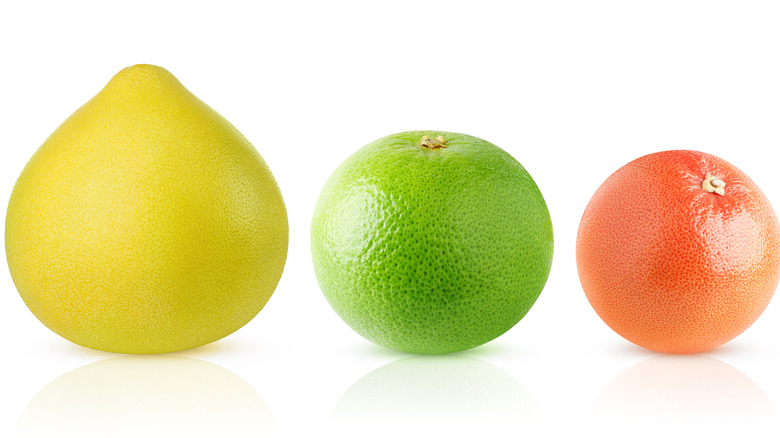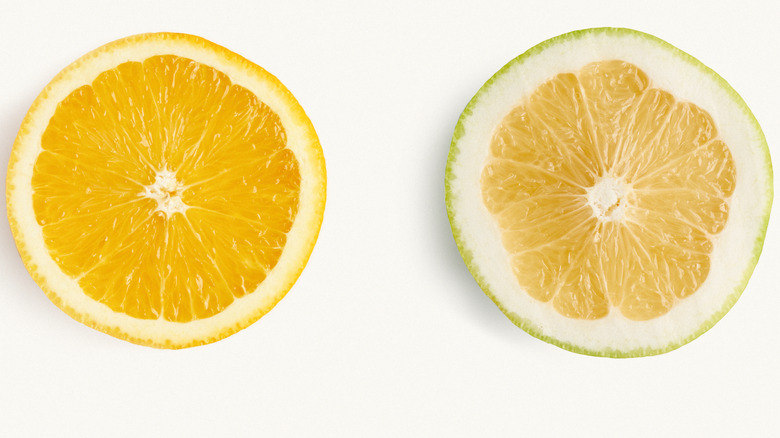The Difference Between A Pomelo And A Grapefruit
Citrus fruits play an incredibly vital role in the culinary world for both sweet and savory dishes. Cooks use everything from the juice to add brightness to sauces, to the zest which adds tons of citrus flavor to marinades, baked goods, and tons more. For the most part, when a recipe calls for citrus, it refers to lemons, limes, or oranges, but citrus certainly isn't limited to these three popular and plentiful options. There are hundreds of types of citrus in the world, per Citrus Pages, but the amazing thing is that all of them were derived from just three: the citron, mandarin, and pomelo (via National Geographic). Everything else is either a natural or manmade hybrid, even those lemons, limes, and oranges.
Because all citrus ultimately comes from a very small gene pool, one could categorize them as having similar characteristics, like being tart and sweet, and containing some type of protective peel. But, of course, there are some very big differences as well. Some are obvious (oranges versus limes, for example), and some are not (lemons versus Meyer lemons). When it comes to pomelos and grapefruits, the similarities and/or differences may be a little hazier, particularly with the large and in charge pomelo, which isn't used nearly as much as its citrus cousins. The two biggest fruits of the bunch may look similar, but they are definitely not the same.
Grapefruit is a pomelo hybrid
The scientific name of a pomelo is citrus maxima, or "greatest citrus," according to The Spruce Eats. Appropriate, considering the fact that it can grow to the size of a basketball and weigh several pounds. One of the original citrus fruits, pomelos originated in the Malaysia-Indonesia region of Asia, per Specialty Produce. When it comes to crossbreeding, the pomelo is often used to make new citrus fruits. MasterClass notes that the tangelo is a mix of the pomelo and a tangerine, and oranges themselves arose from pomelos and mandarins. According to Specialty Produce, it is believed that a ship captain from an East Indian ship named Shaddock first brought pomelo seeds to the West Indies. Sometimes you will hear the pomelo referred to as a shaddock fruit.
Grapefruit is said to have originated in Barbados in the mid-1600s, per Atlas Obscura, making it a relative newcomer to the world of citrus. For comparison's sake, some believe the pomelo was referred to in China as early as 2200 B.C. per SF Gate. When European explorers discovered the West Indies, they planted various citrus trees (including those shaddock seeds) but did not record what they were planting. It is likely that grapefruits came from an unintentional hybridization of oranges and pomelos, which would account for the large size of the fruit with the sweeter (but still a little bitter) flavor.
How do they compare?
Of all the citrus fruit in the world, the pomelo is the largest, growing up to about ten inches in diameter, per Specialty Produce. The extremely thick skin can range in color from light yellow to greenish to sometimes pink. According to The Kitchn, they are often not perfectly round, with the skin tapering up slightly giving some pomelos the appearance of a large avocado. Once the skin and bitter pith is removed, the fruit can also vary in color from white to pink. The Spruce Eats points out that pomelos are actually the least sour of all citrus but also contain the least juice and, contrary to popular belief, they are not bitter, but more sour with some sweetness.
While grapefruits are larger than oranges, lemons, and limes, getting up to about six inches in diameter via The Kitchn, they still pale in size when compared to pomelos. Unlike the pomelo, there are different varieties of grapefruits and they range in color from pale yellow like the Oro Blanco, to peachy pink like the Ruby Red. According to Plants, Genes and People, all grapefruits contain beta carotene and lycopene, which give the fruit their pigments. Lighter grapefruits have less of these pigments while pink and red ones have much more. But lighter color doesn't necessarily mean more bitterness and less sweetness in the grapefruit world; Ask The Food Geek notes that the light Oro Blanco is among the sweetest of all grapefruits.
Can you use one for the other?
Both pomelos and grapefruits share similar qualities in flavor, balancing sweet, tart, and some bitterness, with those elements varying depending on the fruit itself and the season in which they were picked. For example, grapefruits are at their sweetest in the winter months, according to Bon Appétit, and pomelos generally are ripe for picking from the fall through spring, per Specialty Produce. Because the differences in their flavors are fairly slim, The Kitchn suggests that each fruit can be used in cooking and eaten raw in the same ways. However, if your recipe calls for something sweeter, go with pomelos as they tend to be slightly sweeter than many grapefruit varietals.
Both grapefruit and pomelo skins can be candied, but note that there is much more of the white pith to remove when using pomelos. You can use grapefruit and pomelo segments in salads as long as you remove the skin and pith away completely, as these will add much more bitterness to the flavor. Using pomelo juice in a classic paloma would work and make for an interesting twist to the cocktail. You could also use either fruit's juice in salad dressings or sauces. And don't be afraid to use both at once; pomelo would be a welcome addition to a citrus tart that is already featuring oranges and grapefruits.



